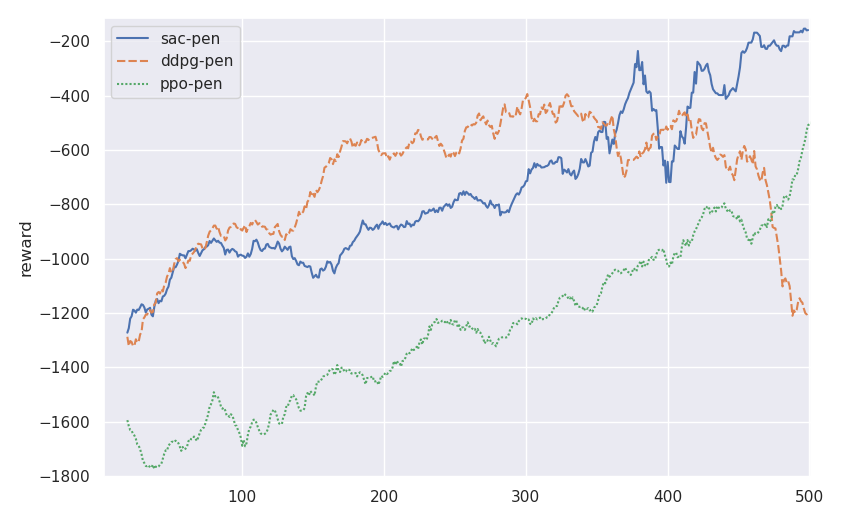Lab 06: SAC
In the lab, you need to implement SAC to solve the task of Pendulum-v0 .
Understand SAC
Read the document from OpenAI spinning up HERE
Focus on understanding the twin Q networks and entropy regularization. Feel free to skip the action squashing part, which we have a similar element in PPO .
Start Code
Adapt code from both DDPG (because it is off-policy and uses replay buffer) and PPO (because it uses stochastic policy).
What to change
Stochastic Policy
-
Use
DDPGcode as a base and migrate the related code fromPPOto change the deterministic policy to stochastic policy. - Keep the neural networks structure similar to
DDPG. Only change the last layer to output \(\mu\) and \(\theta\) (remove theTanh). - Remove the target network for actor
target_act_networkto be consistent with the original paper setup.
Twin Q networks
-
Rename the original
q_netasq1_net,target_q_netastarget_q1_net. -
Create another Q network as
q2_net. Feel free to usedeepcopy
self.q1_net = nn.Sequential(
nn.Linear(n_state + n_action, 400),
nn.ReLU(),
nn.Linear(400, 300),
nn.ReLU(),
nn.Linear(300, 1)
)
self.q2_net = nn.Sequential(
nn.Linear(n_state + n_action, 400),
nn.ReLU(),
nn.Linear(400, 300),
nn.ReLU(),
nn.Linear(300, 1)
)
self.q1_net.to(device)
self.target_q1_net = copy.deepcopy(self.q1_net)
self.target_q1_net.to(device)
self.q2_net.to(device)
self.target_q2_net = copy.deepcopy(self.q2_net)
self.target_q2_net.to(device)
You also need to create dedicate optimizers for q2_net .
- When calculating the
logprobloss from the actor network, refer to the similar part inPPO. Carefully follow the pseudo code in the spinning up document to make sure target networks are used in correct place.
A new kind of Q
As one of the primary contributions of the paper, SAC adapts the soft Q learning that incooperates entropy into the Q function. More mathematic details can be found in the paper or the OpenAI tutorial.
If you have the twin Q networks and stochastic policy network set up, the TD target of soft Q can be calculated as
logprob_ = dist.log_prob(act_).squeeze()
# Calculate y
q_input = torch.cat(
[next_obs, act_], axis=1)
y1 = reward + self.gamma * (1 - done) * \
self.target_q1_net(q_input).squeeze()
y2 = reward + self.gamma * (1 - done) * \
self.target_q2_net(q_input).squeeze()
y = torch.min(y1, y2) - self.alpha*logprob_
Note that logprob_ here need to be calculated as the way we did in PPO. And
self.alpha is a hyper-parameter called temperature factor. Feel free to set it
to 0.2 for now. You will need to tweak this parameter later.
Reparameterization trick for training act_net
Here is the implementation you can adapt to do reparameterization in Pytorch:
dist = Normal(mu, var)
act_ = dist.rsample()
logprob_ = dist.log_prob(act_).squeeze()
Here, mu and var are something from the act_net. By using rsample() instead of sample(), we are able to make act_ carry gradients from act_net.
To calculate the loss of act_net, you can do
logprob_ = dist.log_prob(act_).squeeze()
loss_act = (self.alpha*logprob_ - y).mean()
where y is the minimum Q from q1_net and q2_net.
Write Report
- Run the program with three
self.alphasettings:0.0,0.2,0.5. Record the training log from the three setup and plot the reward curves. - Write your observation/insight on the impact of
self.alpha. - Given several contributions of SAC (e.g., twin Q nets, soft Q learning), which part do you think have the most significant impact on the performance?
Deliverables and Rubrics
Overall, you need to complete the environment installation and be able to run the demo code. You need to submit:
- (70 pts) A PDF from running the your code in jupyter notebook with accuracy reported in the program output.
- (15 pts) Performance: The average of reward reaches above -300 within 500 trials.
- (15 pts) Reasonable answers to the questions (backed up with experiment results)
Debuging Tips
As a reference, here is my training curves comparing with DDPG and PPO:
